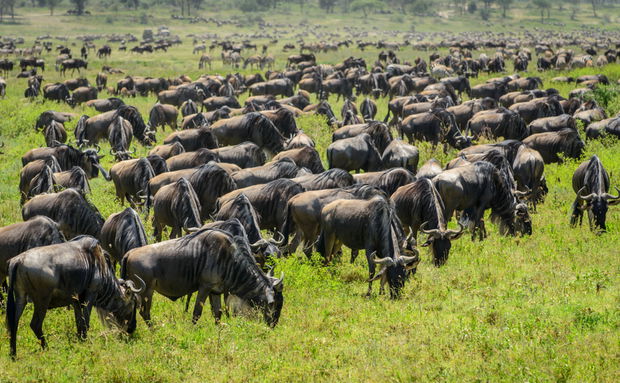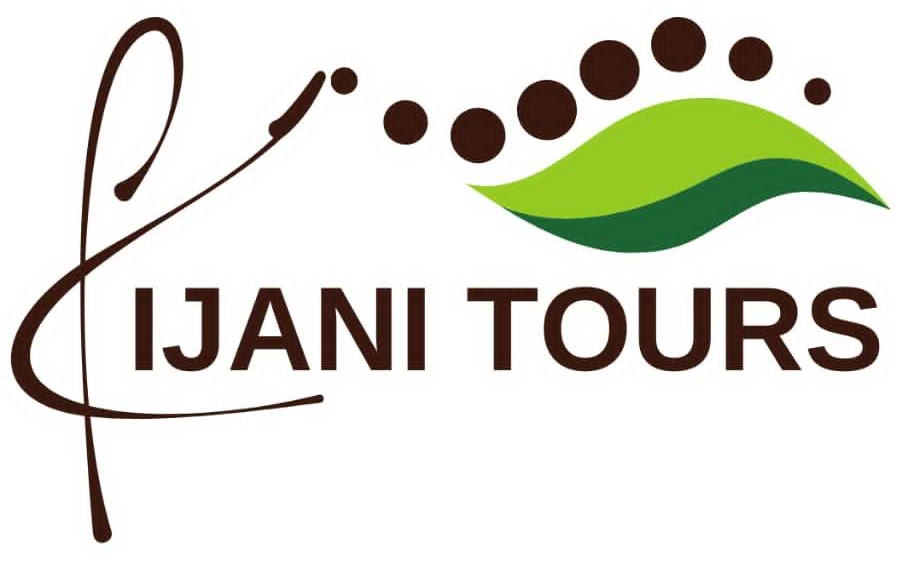8 day Tanzania wildebeest Migration Safari – Calving Season

As the sun rises over the picturesque landscapes of Tanzania, an awe-inspiring spectacle unfolds. During the Great Migration, thousands of wildebeests embark on an epic journey to the lush southern Serengeti and the breathtaking western Ngorongoro. This remarkable trek signals the arrival of the calving season, a thrilling event that takes place from January to February, showcasing nature's spectacular cycle of life.
In the heart of the Southern Serengeti, an incredible spectacle unfolds each year as more than half a million baby wildebeests make their entrance into the world, with an astonishing 8,000 born daily! These spirited little calves must quickly find their feet, learning to walk and run almost immediately to stay in sync with the herd and dodge predators like lions and hyenas. It’s a remarkable testament to the delicate balance of fragility and strength in nature’s wild embrace.
The Southern Serengeti boasts rich soils and generous rainfall, creating the perfect nursery for these young wildebeests. The land is teeming with essential minerals—calcium, sodium, and potassium—that are crucial for their survival and growth. These nutrients not only help in building strong bones but also regulate nerve functions and muscle contractions, supporting the overall vitality of these majestic animals.
Moreover, the nutritious milk produced for the calves is enriched by these minerals, ensuring they get the best start in life. In essence, the Southern Serengeti isn’t just a birthplace; it’s a lifeline, providing everything these wildebeests need for health and well-being as they embark on their incredible journey across the plains.
Add ons
- Tarangire National Park bush walk with armed ranger from Tanzania National Park
- Hot air balloon in Southern Serengeti
Itinerary
DAY 1
A warm and welcoming representative will be waiting for you at the airport ready to take you to your hotel in Arusha.Day 2
After breafast in Arusha drive to Tarangire national park for game driveEmbark on a scenic drive from Arusha to Tarangire National Park for a thrilling game viewing experience. Explore the park on a game drive and encounter elephants, lions, giraffes, and various bird species. After a day of wildlife sightings, settle in for an overnight stay in the African bush. Tarangire National Park offers an unforgettable safari adventure, showcasing the beauty of nature.
Day 3
Embark on an enriching cultural journey at Mto wa MbuEmbark on a cultural journey in Mto wa Mbu with an early morning cultural tour. Explore local markets, farm tour and interact with locals, and witness traditional practices. Enjoy a delicious local lunch showcasing authentic flavors. In the afternoon, drive to Karatu town for the night. Delve into Tanzania's rich cultural tapestry for a chance to learn about local culture and lifestyle.
Day 4
Drive to Serengeti National Park through Ngorongoro HighlandsGet on an exciting journey to Serengeti National Park via Ngorongoro experiencing Tanzania's stunning landscapes and wildlife. In Southern Serengeti enjoy a game drive in Ndutu where you'll see wildebeest and their calves in their natural habitat. Witness the circle of life unfold as you explore the vast plains immersing yourself in the beauty of nature. This adventure will leave you in awe of the wonders of the Serengeti creating unforgettable memories that will last a lifetime.
Day 5
Exploring Ndutu on an Epic Full-Day Game DriveExperience the thrill of a full-day safari in Ndutu during the calving season and witness the breathtaking moment when wildebeest give birth in the short-grass plains near Lake Ndutu. Enjoy the sight of large groups of wildebeests and zebras roaming across the open plains bringing life and movement to the scenery. Keep an eye out for predator-prey encounters as lions cheetahs and hyenas are often close by.
Day 6
Witness the awe-inspiring sight of wildebeest giving birthImmerse yourself in the stunning views of the vast savannah acacia forests and shimmering lakes while exploring this extraordinary ecosystem and making cherished memories of an incredible wildlife experience.
Day 7
Ngorongoro crater tourBegin a journey to Ngorongoro for a memorable experience in Tanzania. Located in the Ngorongoro Conservation Area the Ngorongoro Crater is a natural wonder with the planet's only remaining caldera spanning 260 square kilometers. Prepare for incredible wildlife sightings of the Big Five - lion leopard buffalo elephant and black rhinos as well as vibrant flamingos at Saline Lake Magadi. The diverse terrains within the crater from dense wooded edges to vast grassy plains offer stunning views. Don't miss the chance to witness year-round exceptional wildlife observation in this extraordinary environment.
Day 8
Enjoying Scenic Drives and Conversations on the Way to ArushaAfter breakfast and a small talk, it is time to drive to Arusha and arrive around midday. You can take in the sights and sounds of the city before transferring to Kilimanjaro International Airport for your departure flights. Enjoy the journey and make the most of your time in Tanzania!

Share This Page